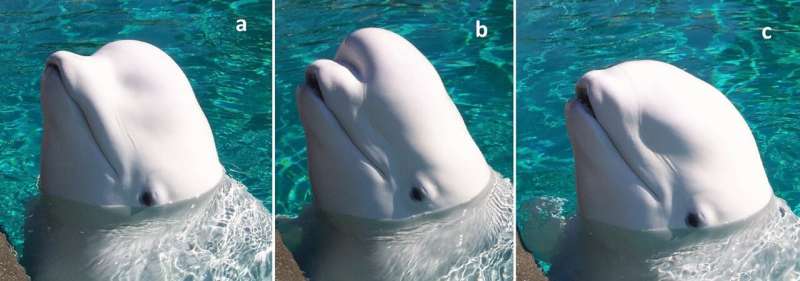March 20, 2024 report
This article has been reviewed according to Science X's editorial process and policies. Editors have highlighted the following attributes while ensuring the content's credibility:
fact-checked
peer-reviewed publication
trusted source
proofread
Researchers explore how beluga whale melon changes shape during social interaction

A trio of animal science researchers at the University of Rhode Island, in the U.S., has identified five major shapes displayed by the beluga whale melon. For their study published in the journal Animal Cognition, Justin Richard, Isabelle Pellegrini, and Rachael Levine observed and recorded the behavior of captive beluga whales.
Prior research has shown that many mammals use facial expressions to communicate simple messages to other creatures, sometimes of their own species, sometimes not. Cetaceans, on the other hand, have strikingly expressionless, stony faces due to the rubbery skin covering their heads.
The only species known to have anything similar to facial expressions is the beluga whale. Members of the species cannot change their faces, but they can manipulate the fatty bulb atop their heads. Known in the field as a melon, the whales change its shape on demand, though why they do so is not known.
To learn more about the melon and why the whales change its shape, the researchers began observing two pairs of them, one male, the other female, at the Mystic Aquarium in Connecticut. They also made observations at a second aquarium in Canada to see if there were any differences based on location.
In studying the whales and recording their behavior, the research team observed 2,570 changes in melon shape. They noted that the vast majority of the time, these occurred during social interactions with their whale-mates—and mostly during line-of-sight events. They also noted that males changed their melon shape much more often than females.
In attempting to categorize the shapes, the researchers identified five that were truly unique and labeled them shake, push, press, lift and flat. Each physically describes what was happening to the melon. They noted that the shake and flat patterns occurred most often during courtship rituals.
The researchers were not able to determine whether the changes in melon shapes were intentional or were reflexes related to other behavior. Nor were they able to decipher the meaning of the shapes, though they suggest it is likely they are meant as some form of communication.
More information: Justin T. Richard et al, Belugas (Delphinapterus leucas) create facial displays during social interactions by changing the shape of their melons, Animal Cognition (2024). DOI: 10.1007/s10071-024-01843-z
Journal information: Animal Cognition
© 2024 Science X Network





















